
ARAGONITE
Specimen ara-22
$ 70.00
Dims: 3.39x1.81x1.30" (8.6x4.6x3.3cm)
Wt: 5.77oz (163.4g)
Agrigennto, Sicily, Italy
This specimen of aragonite is interesting because of the shape of its crystals. They are all hexagons, with white interiors and almost colorless exteriors. Interspersed among these are numerous crystals of sulfur, most of which are not well formed, but their yellow color adds a bit more interest to the specimen. Under ultra-violet light, however, this specimen really stands out. Under long wave, it glows a bright orange (the dealer thinks it glows pink - perhaps his UV lamps are a different wavelength than mine). Under short-wave UV, the aragonite glows a soft green which persists after the light is turned off - it is a phosphorescent specimen. If you have both lights on at the same time, the orange glow dominates but the glow goes instantly to green when the lights are turned off, this is a cool interesting effect!
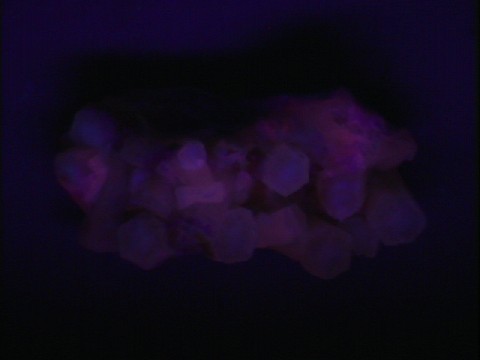
 Amethyst Galleries' Mineral Gallery MINERALS |

ARAGONITE specimen ara-1
$ 65.00
$ 65.00
Dims: 6-3/4" x 3-1/2" x 3-1/4"
Wt: 1 lb., 6.4 oz
Arizona, U.S.A.
The best way to describe this specimen is "unearthly." It consists of two parallel Aragonite stalactites that have "sprouted" crystals on all sides! Some of these have grown into each other, holding the two stalactites together. They have a golden-ornage color, and the crystals that branch from them fade to a milky white towards their terminations. There are hundreds of these crystals, and they take on a large variety of shapes and forms, from prismatic to radiating and almost acicular, to almost boryoidal shapes. It tends to glow a pale white with a sometimes greenish tint(my image of it doesn't do it justice!) under longwave UV light. I have one like this at home.
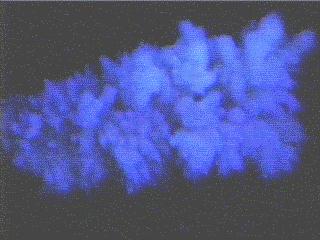

ara-1 ($ 65.00)
Arizona, U.S.A.

ARAGONITE specimen ara-2
$ 15.00
$ 15.00
Dims: 2.2" x 1.2" x 0.8"(5.6 x 1.2 x 0.8 cm)
Wt: 21.9 g
Tecoma Hill, Box Elder County, Utah, U.S.A.
There is not too much to say about this pretty little specimen. Somewhere between a thumbnail and a hand specimen, this piece has about 15 or 20 white orbs of Aragonite growing off of a small brown piece of sandstone or mudstone host rock that has tiny bits of a blue mineral in it(likely a copper mineral of some sort). These orbs are white in color, have a dull luster and a botryoidal habit, and don't exceed 1/4"(6 mm) in diameter. There is a small amount of damage to the cluster, but most of this is confined to those orbs which are on the edge of the specimen.

ara-2 ($ 15.00)
Tecoma Hill, Box Elder County, Utah, U.S.A.

ARAGONITE specimen ara-3
$ 18.00
$ 18.00
Dims: 2.6" x 2.1" x 1.9"(6.6 x 5.3 x 4.8 cm)
Wt: 5.14 oz.(145.9 g)
Bou Azzer, Morocco
This is my favorite variety of Aragonite- I think that the rough hexagonal prismatic crystals that intersect each other in a radiating fashion are wondrous to behold- they make me think of a fusion reactor core! These Moroccan crystals make up a rather heavily-damaged but impressive hand specimen. They are the standard red-brown color for Aragonite from that locality, and have a pearly luster and dim transparence. The largest of these has double basal terminations and dimensions of 1.3 x 0.6 x 0.4"(3.3 x 1.5 x 1.0 cm). Many crystals show damage, and there is one large rough area where the specimen was likely separated from its place of origin. If you like Aragonite, you should certainly have a specimen of this material for your collection.

ara-3 ($ 18.00)
Bou Azzer, Morocco

ARAGONITE specimen ara-5
$ 22.00
$ 22.00
Dims: 3.4" x 2.3" x 2.3"(8.6 x 5.8 x 5.8 cm)
Wt: 6.47 oz.(183.5 g)
Southwest Mine, Bisbee, Cochise County, Arizona, U.S.A.
A strange and complicated set of Aragonite stalactites makes up this specimen. They terminate in oval, bulbous forms and have crystalline offshoots towards one of their bases. Their color is milky white and their luster is pearly at their bases, dulling to a waxy luster and off-white color at their terminations. Close examination reveals definite crystals protruding from the stalactites near their bases, and a few are large enough to be seen without magnification. There are four break points where the specimen was separated from its natural surroundings, but no other damage.

ara-5 ($ 22.00)
Southwest Mine, Bisbee, Cochise County, Arizona, U.S.A.
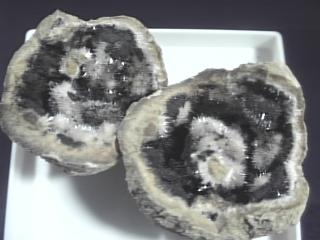
ARAGONITE specimen ara-6
$ 45.00
$ 45.00
Dims: 1.8" x 1.8" x 1.5"(4.6 x 4.6 x 3.8 cm)
Wt: 4.16 oz.(118.1 g) w/ box
Tuscany, Italy
This particular specimen is quite interesting due to the fact that it is made up of two halves of a small geode that are lined with white Aragonite needles. Such geodes, one may say, are not uncommon, but these needle-like Aragonite crystals are often growing out of brown-black patches of botryoidal kutnahorite, a calcium, magnesium, manganese, iron carbonate that forms series' with both dolomite and ankerite. It is opaque and has a slightly silky luster on the tiny mammillary formations. The Aragonite crystals do not exceed 3 mm in length, and have a vitreous luster. The geode's skin appears to be made of shale. Both halves of this geode are affixed to the inside of a plastic specimen box with a removable putty. I really like this specimen- it is both a hand specimen and a "micromount" in one!

ara-6 ($ 45.00)
Tuscany, Italy
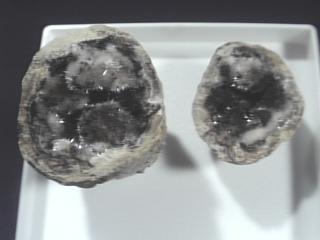
ARAGONITE specimen ara-7
$ 40.00
$ 40.00
Dims: 1.7" x 1.3" x 1.1"(4.3 x 3.3 x 2.8 cm)
Wt: 2.83 oz.(80.3 g) w/ box
Tuscany, Italy
This Aragonite specimen consists of two halves of a small geode that are lined with small, white needle-like crystals of the mineral. They do not exceed 3 mm in length, are translucent, and have a vitreous luster. In many parts of the geode's interior, these crystals appear dirty, as if someone flecked mud on them. This "mud" is actually a calcium, magnesium, manganese, iron carbonate mineral called kutnahorite. Close examination under at least 15-20x magnification shows that these "mud flecks" are actually microscopic botryoidal formations. I can only guess that at least 100x magnification would be needed to discern the individual crystals that make up these formations. The kutnahorite formations seem to have a dull luster, but there is evidence of a faint silky luster in places under a 10-power loupe. The geode's skin appears to be made of shale, and both halves are affixed inside a plastic specimen box with an adhesive putty. This specimen is perfect for one that likes to explore the world of microscopic crystals.

ara-7 ($ 40.00)
Tuscany, Italy

ARAGONITE specimen ara-8
$ 40.00
$ 40.00
Dims: 2.8" x 1.5" x 1.4"(7.1 x 3.8 x 3.6 cm)
Wt: 4.43 oz.(125.8 g) w/ box
Tuscany, Italy
Both halves of a small geode constitute this Italian Aragonite specimen. The crystals are in the form of very thin needles that do not exceed 3 mm in length. They are white in color, appear to be translucent, and have a vitreous luster. Amidst the Aragonite crystals are many small, dark brown patches of kutnahorite, a calcium, magnesium, manganese, iron carbonate. It occurs as small patches of tiny botryoidal formations that are opaque and have a faint silky luster. The thick skin that surrounds them appears to be made of shale, and both halves are affixed inside a plastic specimen box with the use of an adhesive putty.

ara-8 ($ 40.00)
Tuscany, Italy

ARAGONITE specimen ara-10
$ 30.00
$ 30.00
Dims: 1.3" x 1.2" x 1.0"(3.3 x 3.0 x 2.5 cm)
Wt: 1.54 oz.(43.8 g) w/ box
Tuscany, Italy
Another Italian geode, this specimen consists of two small halves that are heavily lined with clusters of radiating, white needles of Aragonite. These crystals do not exceed 3 mm in length and have a vitreous luster. They are a bit too thin to determine whether they are transparent or translucent. Deep within the interior of the larger half of the geode are dark brown-black botryoidal formations of kutnahorite, a carbonate of calcite, magnesium, manganese, and iron. A thin dusting over some of the Aragonite clusters gives them more of a brown color. These formations are opaque and have a dull luster that is almost but not quite silky. The geode's skin is made of shale, and both halves are attached to a plastic specimen box with an adhesive putty.

ara-10 ($ 30.00)
Tuscany, Italy

ARAGONITE specimen ara-11
$ 33.00
$ 33.00
Dims: 1.7" x 1.3" x 1.1"(4.3 x 3.3 x 2.8 cm)
Wt: 1.79 oz.(50.8 g) w/ box
Tuscany, Italy
Two halves of a geode with a shale skin constitute this specimen. Their insides are densely coated with many round clusters made up of hundreds of radiating Aragonite needles. These crystals are white-to-cream in color, have a vitreous luster, and do not exceed 3 mm in length. Also scattered about the interior of each half are dozens of tiny botryoidal aggregates of black kutnahorite crystals. The crystals in the formations are microscopic, and one would likely need at least 50x magnification to examine them individually. The aggregates, in general, have a black color, are opaque, and have a very shiny silky luster. They generally rest at the bases of the clusters that surround them. The geode halves that they rest in are affixed inside a plastic specimen box. It's a neat, compact specimen that will fit in a small space.

ara-11 ($ 33.00)
Tuscany, Italy

ARAGONITE specimen ara-12
$ 33.00
$ 33.00
Dims: 1.0" x 0.9" x 0.8"(2.5 x 2.3 x 2.0 cm)
Wt: 1.09 oz.(31.0 g) w/ box
Tuscany, Italy
This is my favorite specimen of the small Italian Aragonite geodes that we have in stock. Though it is quite small and the pieces therein do not make up an entire geode, it has excellent contrast. Each of the two geodic sections' interiors are lined with a dense matting of white, radiating Aragonite needles that are extremely thin and do not exceed 3 mm in length. They are translucent to transparent and have a vitreous luster. Partially covering the Aragonite crystals are dozens of black, botryoidal formations of kutnahorite, a complex carbonate. The kutnahorite is opaque and has a very shiny, silky luster. It creates a splendid offset for the sparkly, white Aragonite needles. All of this rests on the insides of a shale skin that coats the geode sections. These sections have been affixed inside a plastic specimen box.

ara-12 ($ 33.00)
Tuscany, Italy

ARAGONITE specimen ara-13
$ 20.00
$ 20.00
Dims: 1.1" x 0.9" x 0.7"(2.8 x 2.3 x 1.8 cm)
Wt: 1.19 oz.(33.6 g) w/ box
Tuscany, Italy
These two small geode halves are lined with needle-like Aragonite crystals. The crystals have a pearly-to-dull luster and are colored by rust that may have leached from the other mineral in the geode as it decayed. This other mineral, called kutnahorite, is present in the form of rusty-brown botryoidal formations that rest among the Aragonite needles. They are opaque and have a generally dull luster, but there are a few formations with more of a silky luster. The skin of the geode is made of a shale or a mudstone, and its cross-section makes me think that maybe it formed as the septarian nodules from Utah, U.S.A. did, where the skin started out as small mudballs that dried and cracked, and then were compressed into stone, and subsequently filled with carbonate "goodies".

ara-13 ($ 20.00)
Tuscany, Italy

ARAGONITE specimen ara-14
$ 24.00
$ 24.00
Dims: 1.0" x 0.8" x 0.7"(2.5 x 2.0 x 1.8 cm)
Wt: 28.1 g w/ box
Tuscany, Italy
This little specimen, like others we have in stock, consists of two sections of a small geode that are lined with white, radiating Aragonite needles. These needles do not exceed 3 mm in length, and are nearly as thin as human hair, which means I cannot effectively determine whether they are translucent or transparent. They have a vitreous luster, though, giving them an excellent sparkle. Scattered among the Aragonite clusters are shiny, black botryoidal formations of kutnahorite, a carbonate of calcium, magnesium, manganese, and iron. As the crystals are microscopic in size, I will describe the clusters as being opaque with very well-formed mammillary globules that have a silky luster. They contrast rather nicely with the white Aragonite needles. The skin of these geodic sections is made up of shale or mudstone, and both sections are affixed to the inside of a plastic specimen box.

ara-14 ($ 24.00)
Tuscany, Italy

ARAGONITE specimen ara-15
$ 24.00
$ 24.00
Dims: 1.2 x 0.9 x 0.9" (3.0 x 2.3 x 2.3 cm)
Wt: 1.18 oz. (33.6 g) w/ box
Tuscany, Italy
This thumbnail specimen consists of a small geode that has been broken into 3 pieces. The inner surface of this geode is lined with hundreds of tiny Aragonite needles that do not exceed 0.1" (3 mm) in length, and less than 1 mm in diameter. All are in excellent condition due to the protective hollows of the concave pieces. Though magnification is needed to be sure, I believe that their hexagonal form is very good- individual crystals have a pearly luster on their faces. All appear to be milky-white in coloration and translucent upon first glance, but close examination with a loupe or magnifier shows that each crystal is colorless, transparent, and moderately to dimly clear. Accompanying the Aragonites are many small, brown-black kutnohorite nodules, some of which have an almost crystalline shape. They do not exceed 2 mm in diameter, have a dull, matte luster, and are opaque. The geode skin appears to be made out of a pale brown calcareous shale, and the pieces are affixed to the inside of an oblong specimen box with an adhesive putty.
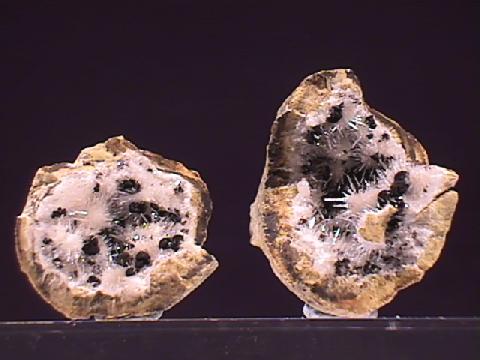

ara-15 ($ 24.00)
Tuscany, Italy

ARAGONITE specimen ara-16
$ 25.00
$ 25.00
Dims: 3.4 x 2.3 x 2.3" (8.6 x 5.8 x 5.8 cm)
Wt: 6.47 oz. (183.5 g)
Bou Azzer, Morocco
Several intergrown clusters of radiating Aragonite prisms make up this hand specimen. These crystals reach maximum visible dimensions of 1.4 x 0.5 x 0.5" (3.6 x 1.3 x 1.3 cm) and are generally in moderately good condition, as many are damaged, broken, and incomplete. The intact crystals have good trigonal prismatic form with hexagonal cross-sections and flat basal terminations- their edges are well-defined and their faces are clean, possessing a bright pearly luster. All have a rusty red coloration that is caused by limonite inclusions and are dimly to moderately transparent. There is a small amount of powdery limonite present in some of the crevices between crystals- this material is easy to remove with a steel probe.

ara-16 ($ 25.00)
Bou Azzer, Morocco

ARAGONITE specimen ara-18
$ 45.00
$ 45.00
Dims: 2.72x2.09x1.22" (6.9x5.3x3.1cm)
Wt: 1.47 oz. (41.6g)
Quangxi Provence, China
This aesthetic specimen appears to consist entirely of aragonite. The base is a plate of micro-crystalline aragonite (although it might be calcite) in several layers of different shades of light brown. The surface has a druse of small opaque brown crystals, and on top are the sprays of excellent translucent pale brown crystals of aragonite. They have an odd habit, in that each crystal in the spray appears to be three parallel crystals. Perhaps this is some kind of twinning, or perhaps it is just a coincidence. Still, the sprays of aragonite crystals are quite pretty, and only a few crystals show damage.


ara-18 ($ 45.00)
Quangxi Provence, China

ARAGONITE specimen ara-22
$ 70.00
$ 70.00
Dims: 3.39x1.81x1.30" (8.6x4.6x3.3cm)
Wt: 5.77oz (163.4g)
Agrigennto, Sicily, Italy
This specimen of aragonite is interesting because of the shape of its crystals. They are all hexagons, with white interiors and almost colorless exteriors. Interspersed among these are numerous crystals of sulfur, most of which are not well formed, but their yellow color adds a bit more interest to the specimen. Under ultra-violet light, however, this specimen really stands out. Under long wave, it glows a bright orange (the dealer thinks it glows pink - perhaps his UV lamps are a different wavelength than mine). Under short-wave UV, the aragonite glows a soft green which persists after the light is turned off - it is a phosphorescent specimen. If you have both lights on at the same time, the orange glow dominates but the glow goes instantly to green when the lights are turned off, this is a cool interesting effect!


ara-22 ($ 70.00)
Agrigennto, Sicily, Italy

ARAGONITE specimen ara-19
$ 50.00
$ 50.00
Dims: 2.54x1.68x1.45" (6.45x4.27x3.68cm)
Wt: 1.91oz (54.1g)
Guangxi Provence, China
These aragonite crystals display as two clusters of nearly radial crystals, all of which are beige and transparent, although their texture is rough (yet vitrious) making them appear barely translucent. The individual crystals have a complex shape (mostly hexagonal in cross section) and taper to a point or to a blade. These do present well.


ara-19 ($ 50.00)
Guangxi Provence, China

ARAGONITE specimen ara-21
$ 30.00
$ 30.00
Dims: 2.00x1.29x1.21" (5.08x3.27x3.07cm)
Wt: 0.71oz (20.1g)
Guangxi Provence, China
This specimen has two intergrown radial clusters of aragonite crystals. Their color is white with enough of a brown tint as to appear beige. The crystals have a resinous luster, and a loupe reveals that they are transparent in thin sections, even though their over-all appearance is translucent. The clusters are nicely perched on a granular mass that is likely more aragonite.

ara-21 ($ 30.00)
Guangxi Provence, China

ARAGONITE specimen ara-20
$ 40.00
$ 40.00
Dims: 3.17x1.42x1.31" (8.06x3.62x3.32cm)
Wt: 1.88oz (53.2g)
Guangxi Provence, China
This is another one of those striking Guangxi aragonites. A piece of rock (which looks like massive aragonite) boasts a radial spray of pale yellow translucent aragonite crystals. While a half-dozen of the crystals are broken, two dozen remain pristine. The individual crystals are long and taper to a point, with a cross section that is similar to the twinned crystals of cinnabar.


ara-20 ($ 40.00)
Guangxi Provence, China